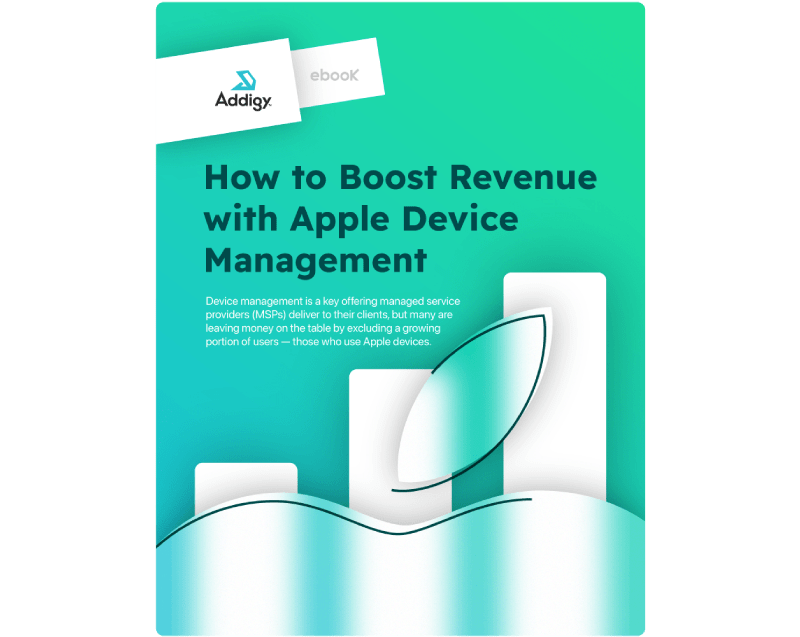How to Boost Revenue with Apple Device Management eBook
Device management is a key offering managed service providers (MSPs) deliver to their clients, but many are leaving money on the table by excluding a growing portion of users — those who use Apple devices.

While Microsoft Windows is the most commonly installed operating system (OS) in the U.S., OS X is gaining market share in North America. Additionally, more than 55 percent of businesses now use or permit the use of Macs.
Industry trends suggest that the increase of Apple device usage in the workplace is showing no sign of slowing down. If you ignore their influx or fail to create a scalable plan for their management, you’re putting your clients’ networks and systems at risk, while also missing out on opportunities to boost revenue.
Let’s dig into the reasons Apple devices are becoming more prevalent in the workplace, why their management is critical, and how your MSP business can benefit.
APPLE DEVICES ARE GOOD FOR BUSINESS
Even though many businesses use Windows devices, the tide is turning.
Apple has renewed its focus on business users as evidenced by its recent innovations. Shortly after introducing Apple silicon in June 2020 — a common architecture that would span across most new Apple products — Apple delivered its new M1 chip, the first silicon “system on a chip” to be designed specifically for the Mac to enhance speed, battery life, screen quality, and industry-leading power efficiency.
“It’s been incredible to see the enthusiasm and momentum for the Mac lineup powered by the M1 family of chips among innovative businesses, prestigious learning institutions, and beyond.”
-Susan Prescott, Vice President of Enterprise and Education Marketing, Apple
Apple devices have also been found to keep employees happy and increase their productivity. An IBM report found that Mac users are 17 percent less likely to leave the company they work for compared to Windows users. Additionally, Mac users are 22 percent more likely to exceed expectations in performance reviews compared to Windows users.
With results like these, it’s no wonder businesses are warming up to Apple devices.
APPLE IS DRIVING LOYALTY AND GROWTH THROUGH SERVICES
When most people think about Apple, its tangible products come to mind, particularly the iPhone. Known for changing several industries over the past decade, including the PC and telecom markets, the iPhone has generated billions of dollars in sales. However, to combat the inevitable saturation of the iPhone market, Apple began shifting its focus to selling services in 2015.
Apple’s services, such as streaming music, movies, and TV, original programming, and app purchases have not only generated revenue, but have contributed to heightened brand awareness and customer loyalty. For Apple, services are key to its future.
The momentum Apple is seeing from its services business isn’t expected to let up anytime soon. In fact, the tech giant’s services business may become the company’s most profitable business within the next four years.
Apple’s sales from its services business is projected to grow at a rate of about 11 percent a year to $81.5 billion in the fiscal year 2024.
Already known for its portfolio of superior products, Apple services expand the brand with unique experiences that further embed the user within its ecosystem and drive device preference.
FLEXIBLE WORK OPTIONS ARE HERE TO STAY
The COVID-19 pandemic forced companies and their employees to adapt to remote work. The result: a workplace that is forever changed.
Instead of requiring a return to the office (and spending money on unnecessary overhead, including costly office space), many businesses adopted permanent remote work policies, while others implemented hybrid work models with employees splitting time between the office and home. Remote work offers organizations a competitive advantage in a tight labor market and will continue to be part of management’s conversation with IT decision-makers moving forward.

While businesses have traditionally relied on Windows devices, employees now have greater flexibility to decide where and how they work. More than half of small and mid-sized companies now have Apple devices within their organizations; many are the result of bring your own device (BYOD) policies and employee preference toward Apple products.
“Growth in Mac usage among business users, especially for employees working remotely and given their choice of PC device, is pushing more businesses to formally adopt management tools and strategies around macOS, along with iOS/iPadOS and tvOS.”
-Phil Hochmuth, Program Vice President, Enterprise Mobility and Client Endpoint Management, IDC
Whether you’re managing a traditional, hybrid, or fully-remote office environment — or a combination of all three — end-user expectations remain unchanged. They expect their devices to be kept up-to-date, secure from cyber threats, and running at peak performance.
If you’ve been neglecting Apple devices, this presents an opportunity to level up. With the right Apple device management software, you can provide endpoint security and device monitoring and management while obtaining real-time visibility into networks to ensure all end users receive a consistent experience regardless of their OS.
LEVERAGE AN APPLE DEVICE MANAGEMENT SOLUTION TO ENHANCE DEVICE SECURITY
Cybersecurity is always top of mind for CEOs, as the daily coverage of massive global hacks in the media is a reminder of what could happen. Cybercriminals have exploited many well-known companies, including Kaseya, the Colonial Pipeline Company, and Acer. While these incidents made the list of top cyber incidents in 2021, there was a 50 percent increase in overall attacks per week on corporate networks compared to 2020. Without a doubt, cybersecurity is a concern for businesses of all sizes.
Even though the biggest incidents in cybersecurity make the headlines, 43 percent of cyberattacks target small businesses. Taking size into account, cyberattacks are costing businesses $200,000 on average, according to insurance carrier Hiscox. Even worse, 60 percent of companies go out of business within six months of being victimized.
While many cyberattacks target non-Apple devices, cybercriminals are increasingly targeting iPhones and Macs. For instance, in 2021 cybercriminals released malware tailored to run on Apple’s M1 processors.
“Malware authors are evolving and adapting to keep up with Apple’s latest hardware and software.”
-Patrick Wardle, Apple Expert
Properly securing Apple devices is more important than ever; it’s an essential part of protecting your clients’ systems and networks. Being able to quickly identify, analyze, and evaluate emerging threats is crucial for MSPs protecting increasingly complex IT environments. If irregularities on client devices and networks are detected, MSPs must be able to attend to them immediately.
Unfortunately, traditional remote monitoring and management (RMM) tools aren’t enough to effectively secure, manage, and protect Apple devices because they were built for Windows machines. Although RMM tools have their place, MSPs will need an Apple device management solution to efficiently support monitoring and remediation, keep OS and third-party software patched, apply and enforce security policies, keep machines protected from ransomware and other cyber threats, and ensure end users have a consistent experience at scale.
Because executives are concerned about cyber threats, they are investing more time, money, and resources in finding solutions to combat cybercrime. Proactively approaching your customers to close security loopholes not only builds trust, but also creates opportunities for additional revenue.
SKIP REPETITIVE TASKS AND SAVE MONEY
Simply put, automating processes saves not only time but also money in the long run. It enables you to divert your resources to critical areas of your business instead of on repetitive and oftentimes tedious tasks. While many MSPs are aware of the important role automation plays in managed services today, implementing automation isn’t always easy.
An Apple device management solution will help to streamline the automation process. For example, automating device enrollment and deployment, which you can enable by configuring Automated Device Enrollment in Apple Business Manager, is key to ensuring client networks are secure, and devices are configured, deployed, patched, and maintained. By automating this process, you allow yourself to shift focus to building relationships with customers and prospects, increasing productivity, and generating additional revenue streams.
Also, if you select a multi-tenant Apple device management solution, such as Addigy, you’ll be able to produce more revenue against the cost of your engineers by enabling them to customize automations and use them across the entire client base.
Apple’s growing popularity with business users opens many opportunities for MSPs to boost revenue. Because Apple continues to innovate its products and increase their usage through its services, Apple devices are more embedded in user lives than ever, and with the boon of flexible work options, employees are choosing to bring their Apple devices into the workplace at a record pace. MSPs who are armed with an Apple device management solution are equipped to take advantage of these trends, efficiently and effectively securing Apple devices from emerging threats, maintaining a consistent user experience, and heightening customer satisfaction.
